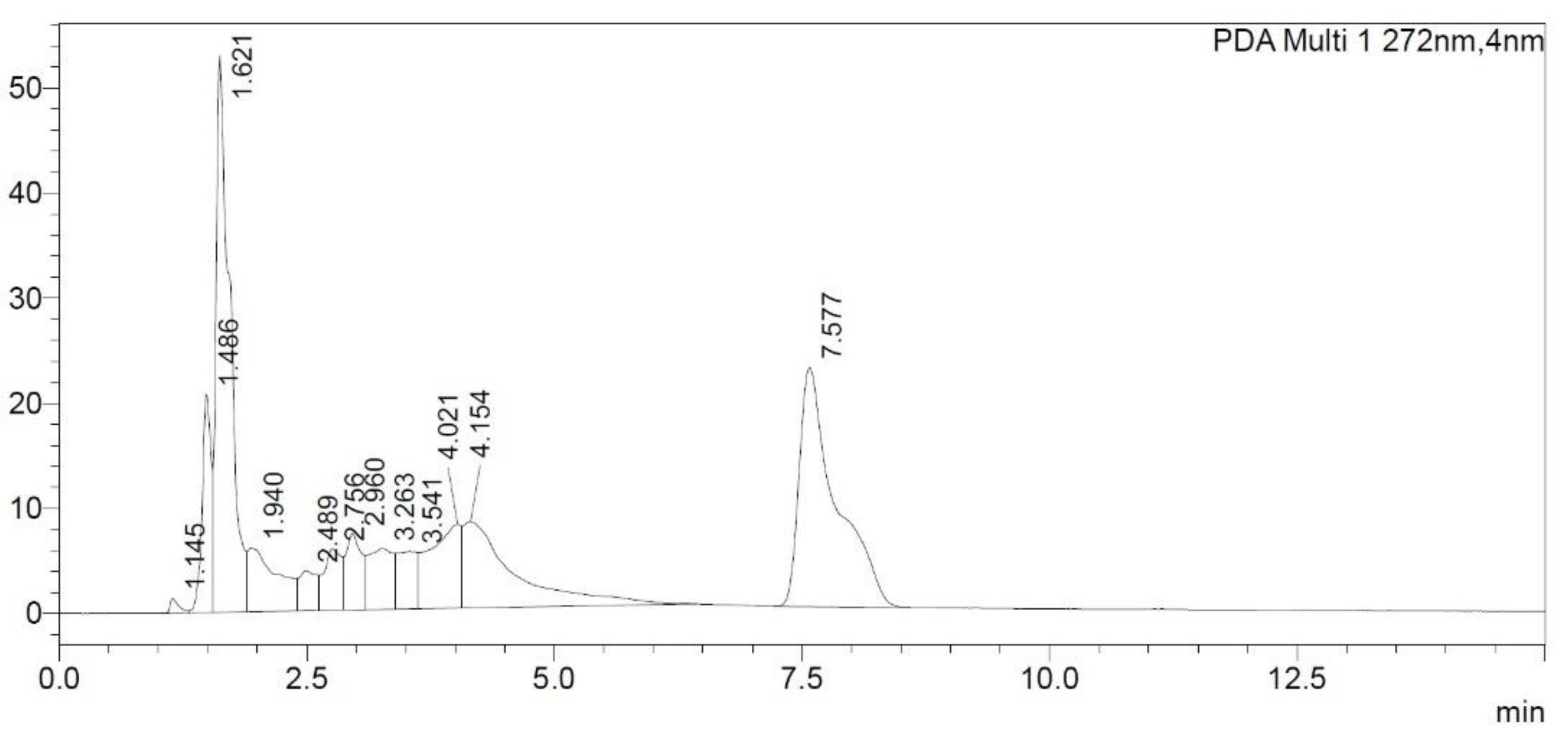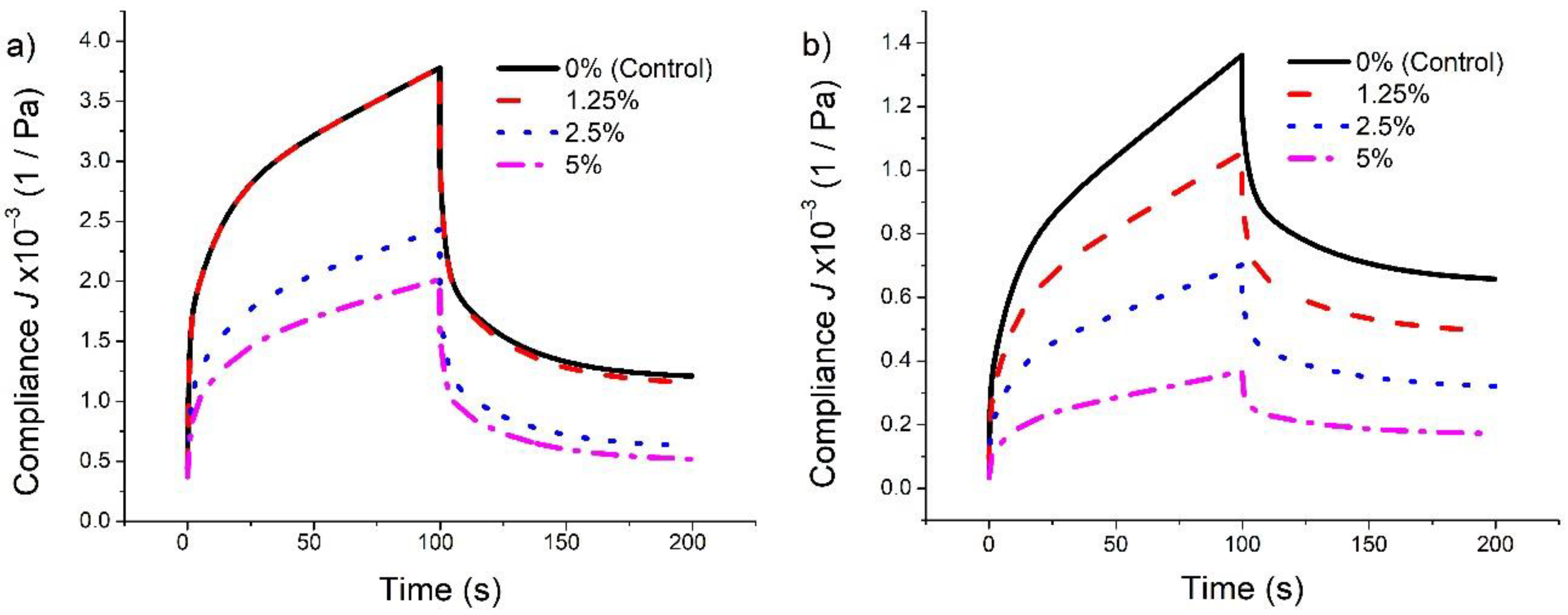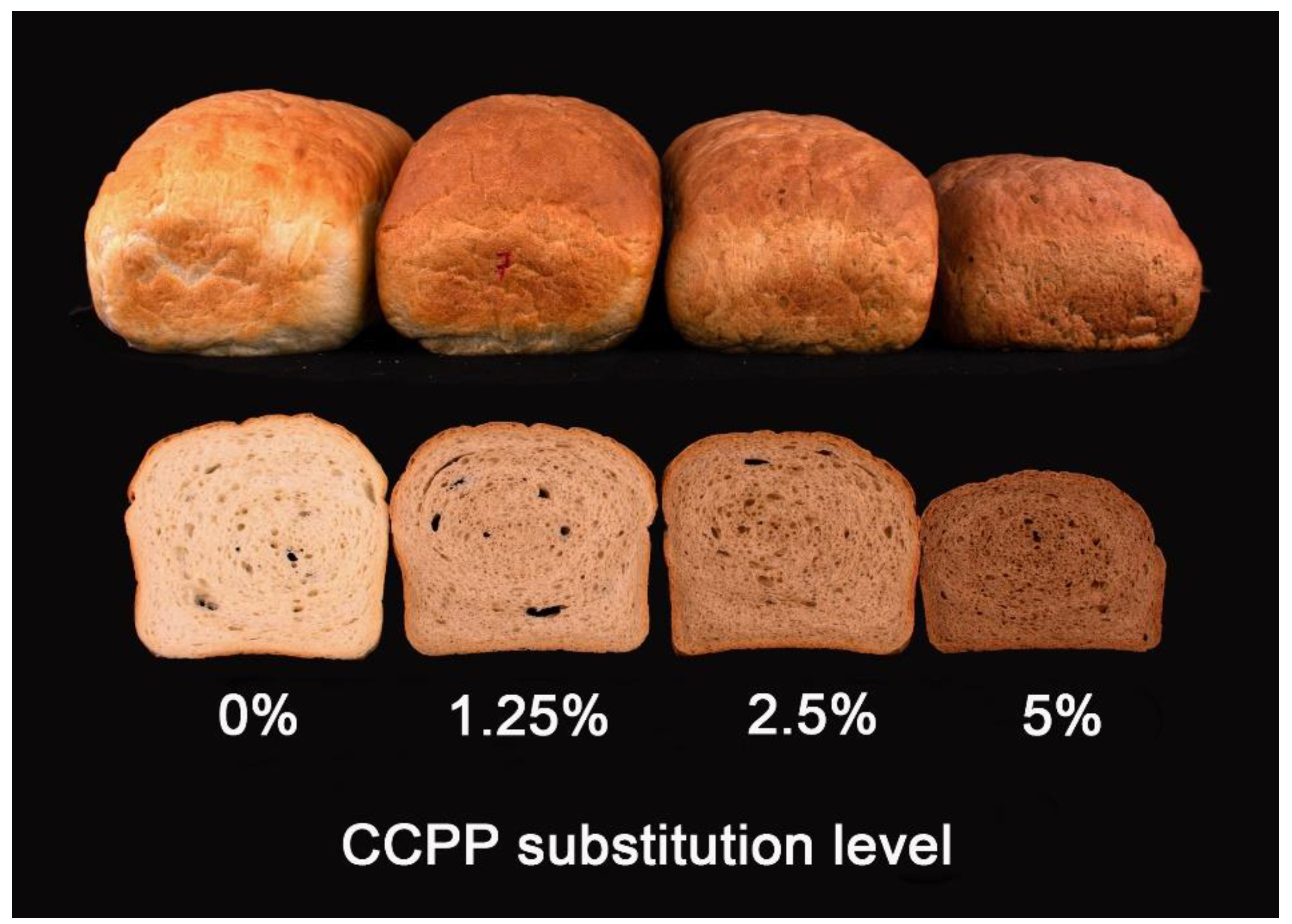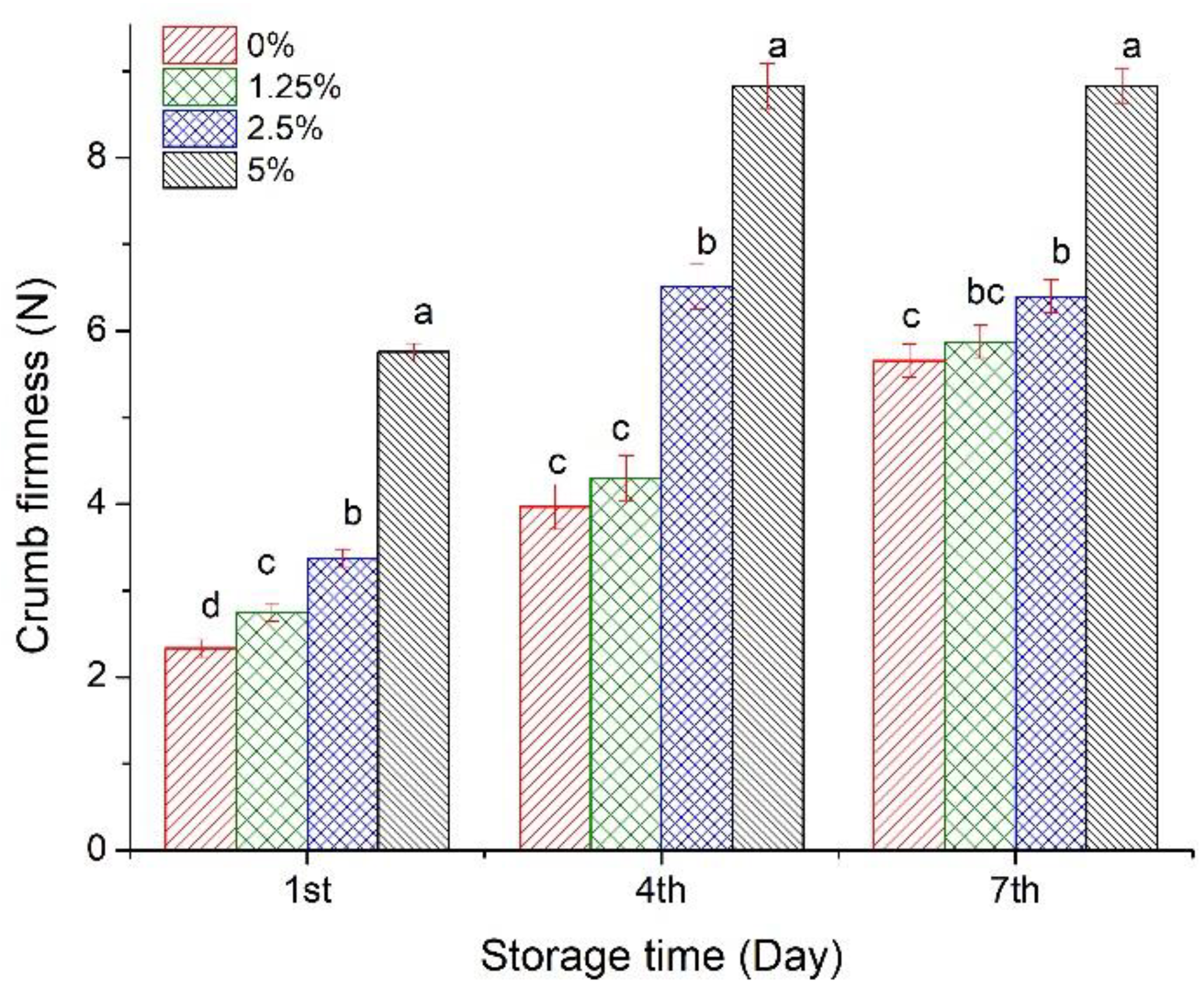Coffee Cherry Pulp by-Product as a Potential Fiber Source for Bread Production: A Fundamental and Empirical Rheological Approach
Abstract
1. Introduction
2. Materials and Methods
2.1. Materials
2.2. Flour and CCPP Analysis
Caffeine Concentration in CCPP
2.3. Sample Preparation for Rheology Test
2.3.1. Gluten Samples Preparation
2.3.2. Dough Sample Preparation
2.4. Compression-Recovery, Bi-Axial Deformation
2.5. Dough and Gluten Sample Loading for Creep and Recovery Test
2.6. Modeling of Viscoelastic Properties of Bread Dough and Gluten
2.7. Bread Baking Quality
2.8. Statistical Analysis
3. Results and Discussion
3.1. Wheat Flour and CCPP Analysis
3.2. Water Absorption and Mixing Properties
3.3. Compression-Recovery
3.4. Creep-Recovery Test
3.5. Bread Volume and Crumb Firmness
4. Conclusions
Author Contributions
Funding
Acknowledgments
Conflicts of Interest
Abbreviations
| CCP | Coffee cherry pulp |
| CCPP | Coffee cherry pulp powder |
| CONACyT | National Council for Science and Technology |
| HPLC | High Performance Liquid Chromatography |
| WA | Water absorption |
| MTI | Mixing Tolerance Index |
| ER | Elastic recovery |
| USDA | United States Department of Agriculture |
Appendix A. HPLC Caffeine Determination

Appendix B. Pearson’s Correlation
| Gluten | ||||||||||||
|---|---|---|---|---|---|---|---|---|---|---|---|---|
| Parameters | J0 | G0 | J1 | G1 | λ1 | J2 | G2 | λ2 | η0 | η1 | η2 | ER |
| Development time | 0.64 * | −0.69 * | 0.66 * | −0.69 * | ns | 0.73 ** | −0.72 ** | ns | −0.73 ** | −0.66 * | −0.70 * | 0.76 ** |
| Stability time | 0.64 * | −0.63 * | 0.65 * | −0.63 * | ns | 0.71 * | −0.66 * | ns | −0.66 * | −0.60 * | −0.64 * | 0.72 ** |
| Firmness (Day 1) | −0.86 ** | 0.90 *** | −0.85 ** | 0.89 *** | ns | −0.85 ** | 0.87 ** | 0.65* | 0.87 ** | 0.89 *** | 0.89 *** | −0.89 ** |
| Mixing tolerance | −0.89 *** | 0.88 ** | −0.90 *** | 0.87 ** | ns | −0.90 *** | 0.87 ** | 0.62* | 0.85 ** | 0.87 ** | 0.88 ** | −0.87 ** |
| Weight | ns | ns | ns | ns | ns | ns | ns | ns | ns | ns | ns | ns |
| Volume | 0.94 *** | −0.94 *** | 0.94 *** | −0.93 *** | −0.57 + | 0.92 *** | −0.92 *** | −0.70* | −0.91 *** | −0.93 *** | −0.93 *** | 0.91 *** |
| Water absorption | −0.85 ** | 0.90 *** | −0.85 ** | 0.90 *** | ns | −0.87 ** | 0.89 *** | 0.59* | 0.90 *** | 0.88 ** | 0.90 *** | −0.91 *** |
| Elastic recovery | 0.89 ** | −0.92 *** | 0.89 *** | −0.91 *** | ns | 0.89 ** | −0.90 *** | −0.66* | −0.89 ** | −0.91 *** | −0.91 *** | 1 |
| Dough | ||||||||||||
| Development time | 0.75 ** | −0.70 * | 0.73 ** | −0.69 * | ns | 0.70 * | −0.68 * | ns | −0.70 * | −0.69 * | −0.67 * | 0.76 ** |
| Stability time | 0.78 ** | −0.64 * | 0.78 ** | −0.63 * | 0.65 * | 0.76 ** | −0.63 * | ns | −0.65 | −0.61 | −0.61 | 0.72 ** |
| Firmness (Day 1) | −0.90 *** | 0.99 *** | −0.87 ** | 0.99 *** | −0.68 * | −0.86 ** | 0.98 *** | ns | 0.98 *** | 0.97 *** | 0.99 *** | −0.89 ** |
| Mixing tolerance | −0.95 *** | 0.87 ** | −0.94 *** | 0.86 ** | −0.77 ** | −0.93 *** | 0.86 ** | ns | 0.87 ** | 0.85 ** | 0.84 ** | −0.87 ** |
| Weight | ns | ns | ns | ns | ns | ns | ns | ns | ns | ns | ns | ns |
| Volume | 0.98 *** | −0.95 *** | 0.97 *** | −0.94 *** | 0.82 ** | 0.95 *** | −0.94 *** | ns | −0.95 *** | −0.92 *** | −0.93 *** | 0.91 *** |
| Water absorption | −0.91 *** | 0.97 *** | −0.87 ** | 0.97 *** | −0.72 * | −0.86 ** | 0.96 *** | ns | 0.97 *** | 0.94 *** | 0.98 *** | −0.91 *** |
| Elastic recovery | 0.89 *** | −0.91 *** | 0.87 ** | −0.90 *** | 0.65 * | 0.84 ** | −0.89 ** | ns | −0.90 *** | −0.88 ** | −0.90 *** | 1 |
References
- Esquivel, P.; Jiménez, V.M. Functional properties of coffee and coffee by-products. Food Res. Int. 2012, 46, 488–495. [Google Scholar] [CrossRef]
- Braham, J.E.; Bressani, R. Coffee Pulp Composition, Technology, and Utilization; International Development Research Centre: Ottawa, ON, Canada, 1979. [Google Scholar]
- Murthy, P.S.; Madhava Naidu, M. Sustainable management of coffee industry by-products and value addition—A review. Resour. Conserv. Recycl. 2012, 66, 45–58. [Google Scholar] [CrossRef]
- Magoni, C.; Bruni, I.; Guzzetti, L.; Dell’Agli, M.; Sangiovanni, E.; Piazza, S.; Regonesi, M.E.; Maldini, M.; Spezzano, R.; Caruso, D.; et al. Valorizing coffee pulp by-products as anti-inflammatory ingredient of food supplements acting on IL-8 release. Food Res. Int. 2018, 112, 129–135. [Google Scholar] [CrossRef] [PubMed]
- Bonnand-Ducasse, M.; Della Valle, G.; Lefebvre, J.; Saulnier, L. Effect of wheat dietary fibres on bread dough development and rheological properties. J. Cereal Sci. 2010, 52, 200–206. [Google Scholar] [CrossRef]
- Anil, M. Using of hazelnut testa as a source of dietary fiber in breadmaking. J. Food Eng. 2007, 80, 61–67. [Google Scholar] [CrossRef]
- Deka, S.C.; Seth, D.; Hulle, N.R.S. Technologies for Value Addition in Food Products and Processes; CRC Press: Boca Raton, FL, USA, 2019. [Google Scholar]
- Faubion, J.M.; Hoseney, R.C. The viscoelastic properties of wheat flour doughs. In Dough Rheology and Baked Product Texture; Faridi, H., Faubion, J.M., Eds.; Van Nostrand Reinhold: New York, NY, USA, 1990; pp. 29–66. [Google Scholar]
- Dobraszczyk, B.J.; Morgenstern, M.P. Rheology and the breadmaking process. J. Cereal Sci. 2003, 38, 229–245. [Google Scholar] [CrossRef]
- Edwards, N.; Dexter, J.; Scanlon, M.; Cenkowski, S. Relationship of creep-recovery and dynamic oscillatory measurements to durum wheat physical dough properties. Cereal Chem. 1999, 76, 638–645. [Google Scholar] [CrossRef]
- Fu, Z.-Q.; Che, L.-M.; Li, D.; Wang, L.-J.; Adhikari, B. Effect of partially gelatinized corn starch on the rheological properties of wheat dough. LWT-Food Sci. Technol. 2016, 66, 324–331. [Google Scholar] [CrossRef]
- Girard, A.L.; Castell-Perez, M.E.; Bean, S.R.; Adrianos, S.L.; Awika, J.M. Effect of Condensed Tannin Profile on Wheat Flour Dough Rheology. J. Agric. Food Chem. 2016, 64, 7348–7356. [Google Scholar] [CrossRef]
- Hernández-Estrada, Z.J.; Rayas-Duarte, P.; Cárdenas, J.d.D.F. Creep Recovery of Wet Gluten and High-Molecular-Weight Glutenin Subunit Composition: Relationship with Viscoelasticity of Dough and Breadmaking Quality of Hard Red Winter Wheat. Cereal Chem. J. 2017, 94, 223–229. [Google Scholar] [CrossRef]
- Steffe, J.F. Rheological Methods in Food Process Engineering; Freeman Press: East Lansing, MI, USA, 1996. [Google Scholar]
- Mironeasa, S.; Codina, G.G. Dough Rheological Behavior and Microstructure Characterization of Composite Dough with Wheat and Tomato Seed Flours. Foods 2019, 8, 626. [Google Scholar] [CrossRef]
- Mironeasa, S.; Iuga, M.; Zaharia, D.; Mironeasa, C. Rheological analysis of wheat flour dough as influenced by grape peels of different particle sizes and addition levels. Food Bioprocess Technol. 2019, 12, 228–245. [Google Scholar] [CrossRef]
- Chompoorat, P.; Rayas-Duarte, P.; Hernandez-Estrada, Z.J.; Phetcharat, C.; Khamsee, Y. Effect of heat treatment on rheological properties of red kidney bean gluten free cake batter and its relationship with cupcake quality. J. Food Sci. Technol. 2018, 55, 4937–4944. [Google Scholar] [CrossRef]
- Ronda, F.; Pérez-Quirce, S.; Angioloni, A.; Collar, C. Impact of viscous dietary fibres on the viscoelastic behaviour of gluten-free formulated rice doughs: A fundamental and empirical rheological approach. Food Hydrocoll. 2013, 32, 252–262. [Google Scholar] [CrossRef]
- Jin, X.; Lin, S.; Gao, J.; Wang, Y.; Ying, J.; Dong, Z.; Zhou, W. How manipulation of wheat bran by superfine-grinding affects a wide spectrum of dough rheological properties. J. Cereal Sci. 2020, 96, 103081. [Google Scholar] [CrossRef]
- Ghoshal, G.; Shivhare, U.S.; Banerjee, U.C. Rheological properties and microstructure of xylanase containing whole wheat bread dough. J. Food Sci. Technol. 2017, 54, 1928–1937. [Google Scholar] [CrossRef]
- Association of Official Analytical Chemist (AOAC). Official Methods of Analysis of AOAC International, 18th ed.; AOAC: Gaithersburg, MD, USA, 2005. [Google Scholar]
- AACCI. International Approved Methods of Analysis, 11th ed.; Available online: http://methods.aaccnet.org/toc.aspx (accessed on 10 August 2020).
- ISO. Coffee and Coffee Products-Determination of the Caffeine Content Using High Performance Liquid Chromatography (HPLC); Reference Method ISO 20481; ISO International Standards: Geneva, Switzerland, 2008. [Google Scholar]
- AIB. White Pan Bread Firmness Measurement. In AIB Standard Procedure; AIB International: Manhattan, KS, USA, 2006; Available online: https://www.aibinternational.com/Portals/0/AIBTextureAnalysisProcedures.pdf (accessed on 8 October 2020).
- Boita, E.R.F.; Oro, T.; Bressiani, J.; Santetti, G.S.; Bertolin, T.E.; Gutkoski, L.C. Rheological properties of wheat flour dough and pan bread with wheat bran. J. Cereal Sci. 2016, 71, 177–182. [Google Scholar] [CrossRef]
- Chouaibi, M.; Rezig, L.; Boussaid, A.; Hamdi, S. Insoluble tomato-fiber effect on wheat dough rheology and cookies’ quality. Ital. J. Food Sci. 2019, 31, 1–18. [Google Scholar]
- Han, W.; Ma, S.; Li, L.; Zheng, X.; Wang, X. Gluten aggregation behavior in gluten and gluten-starch doughs after wheat bran dietary fiber addition. LWT-Food Sci. Technol. 2019, 106, 1–6. [Google Scholar] [CrossRef]
- Wirkijowska, A.; Zarzycki, P.; Sobota, A.; Nawrocka, A.; Blicharz-Kania, A.; Andrejko, D. The possibility of using by-products from the flaxseed industry for functional bread production. LWT-Food Sci. Technol. 2020, 118, 108860. [Google Scholar] [CrossRef]
- Chapman, S.J.; Mulvaney, S.J.; Chinnaswamy, R.; Rayas-Duarte, P.; Allvin, B. Large deformation stress relaxation and compression-recovery of gluten representing different wheat classes. J. Cereal Sci. 2012, 55, 366–372. [Google Scholar] [CrossRef]
- Zhou, Y.; Dhital, S.; Zhao, C.; Ye, F.; Chen, J.; Zhao, G. Dietary fiber-gluten protein interaction in wheat flour dough: Analysis, consequences and proposed mechanisms. Food Hydrocoll. 2021, 111, 106203. [Google Scholar] [CrossRef]
- Peressini, D.; Sensidoni, A. Effect of soluble dietary fibre addition on rheological and breadmaking properties of wheat doughs. J. Cereal Sci. 2009, 49, 190–201. [Google Scholar] [CrossRef]
- Sangnark, A.; Noomhorm, A. Effect of dietary fiber from sugarcane bagasse and sucrose ester on dough and bread properties. LWT-Food Sci. Technol. 2004, 37, 697–704. [Google Scholar] [CrossRef]
- Sakhare, S.D.; Prabhasankar, P. Effect of Roller Mill Processed Fenugreek Fiber Addition on Rheological and Bread Making Properties of Wheat Flour Doughs. J. Food Process. Preserv. 2017, 41, e13012. [Google Scholar] [CrossRef]




| Compounds | CCPP (g/100 g) | Wheat Flour (g/100 g) |
|---|---|---|
| Moisture | 6.1 ± 0.0 | 12.6 |
| Protein | 9.7 ± 0.1 | 11.7 |
| Dietary fiber | 44.5 ± 0.6 | 2.37 |
| Ash | 4.2 ± 0.1 | 1.09 |
| Lipids | 1.5 ± 0.0 | <1.0 |
| Caffeine *** | 0.04 ± 0.0 | n.a. |
| Total carbohydrates ** | 78.7 | 73.5 |
| CCPP Substitution Level (% Wet Basis) | Water Absorption (%) | Development Time (min) | Stability Time (min) | Mixing Tolerance Index (BU) | Time to Break Down (min) |
|---|---|---|---|---|---|
| 0 (Control) | 62.1 ± 0.1 a | 11.0 ± 1.7 a | 16.3 ± 1.7 a | 19.7 ± 3.2 a | 18.9 ± 1.7 a |
| 1.25 | 62.2 ± 0.1 a | 9.4 ± 0.5 ab | 9.8 ± 0.8 b | 39.7 ± 4.0 b | 12.5 ± 0.8 b |
| 2.5 | 62.6 ± 0.1 b | 8.4 ± 0.1 ab | 8.7 ± 0.2 b | 53.0 ± 2.6 c | 11.1 ± 0.4 bc |
| 5 | 63.8 ± 0.1 c | 7.7 ± 0.3 b | 8.2 ± 0.1 b | 63.3 ± 5.7 c | 9.8 ± 0.3 c |
| Substitution Level | Gluten | Dough | ||||||
|---|---|---|---|---|---|---|---|---|
| 0% | 1.25% | 2.5% | 5% | 0% | 1.25% | 2.5% | 5% | |
| Parameters | Creep Phase (Gluten) | Creep Phase (Dough) | ||||||
| G0 (Pa) × 103 | 1.5 ± 0.1 c | 1.5 ± 0.1 c | 2.2 ± 0.1 b | 2.6 ± 0.2 a | 10.8 ± 0.4 c | 13.1 ± 1.3 c | 17.8 ± 0.7 b | 30.6 ± 2.1 a |
| G1 (Pa) × 103 | 1.2 ± 0.1 c | 1.2 ± 0.1 c | 1.7 ± 0.1 b | 2.1 ± 0.2 a | 4.8 ± 0.3 d | 6.3 ± 1.0 c | 8.9 ± 0.6 b | 17.3 ± 0.9 a |
| G2 (Pa) × 103 | 1.1 ± 0.1 c | 1.0 ± 0.0 c | 1.5 ± 0.1 b | 1.7 ± 0.1 a | 7.1 ± 0.5 c | 9.2 ± 1.9 c | 13.5 ± 0.9 b | 26.6 ± 2.3 a |
| η0 (Pa) × 105 | 1 ± 0.1 a | 1 ± 0.1 a | 1.4 ± 0.1 b | 1.7 ± 0.1 c | 1.5 ± 0.1 a | 2.1 ± 0.3 a | 3.2 ± 0.1 b | 6.1 ± 0.5 c |
| Max strain (%) | 34.2 ± 2.3 a | 34.3 ± 0.8 a | 24.0 ± 1.3 b | 20.1 ± 1.7 c | 13.4 ± 0.8 a | 10.4 ± 1.8 b | 6.9 ± 0.4 c | 3.6 ± 0.3 d |
| Recovery Phase (Gluten) | Recovery Phase (Dough) | |||||||
| Gr0 (Pa) × 103 | 1.3 ± 0.1 c | 1.3 ± 0.1 c | 1.8 ± 0.1 b | 2.2 ± 0.2 a | 5.5 ± 0.1 c | 6.9 ± 0.8 c | 9.5 ± 0.6 b | 17.5 ± 1.3 a |
| Gr1 (Pa) × 103 | 1.1 ± 0.1 c | 1.1 ± 0.1 c | 1.6 ± 0.1 b | 1.9 ± 0.2 a | 4.0 ± 0.1 c | 5.2 ± 0.8 c | 7.9 ± 0.6 b | 16.6 ± 1.1 a |
| Gr2 (Pa) × 103 | 1.1 ± 0.1 c | 1.1 ± 0.0 c | 1.6 ± 0.1 b | 1.8 ± 0.2 a | 3.5 ± 0.2 c | 4.5 ± 0.7 c | 6.4 ± 0.3 b | 12.1 ± 0.8 a |
| Final strain (%) | 8.4 ± 0.6 a | 8.0 ± 0.7 a | 5.9 ± 0.7 b | 5.0 ± 0.5 b | 6.3 ± 0.5 a | 4.8 ± 1 b | 3.0 ± 0.1 c | 1.6 ± 0.2 d |
| Recovery (%) | 75.4 ± 2.3 a | 76.7 ± 2.3 a | 75.6 ± 2.1 a | 74.9 ± 2.1 a | 53 ± 1.4 b | 54 ± 1.9 ab | 55 ± 0.6 a | 54 ± 1.2 ab |
| CCPP Substitution Level (% Wet Basis) | Height (mm) | Weight (g) | Volume (cm3) | Specific Volume (cm3/g) |
|---|---|---|---|---|
| 0 (Control) | 127 ± 5 a | 736 ± 4 a | 3056 ± 108 a | 4.14 ± 0.1 a |
| 1.25 | 118 ± 3 a | 739 ± 3 a | 2804 ± 87 b | 3.79 ± 0.1 b |
| 2.5 | 106 ± 5 b | 735 ± 12 a | 2408 ± 98 c | 3.28 ± 0.1 c |
| 5 | 91 ± 2 c | 737 ± 1 a | 2007 ± 45 d | 2.72 ± 0.1 d |
Publisher’s Note: MDPI stays neutral with regard to jurisdictional claims in published maps and institutional affiliations. |
© 2021 by the authors. Licensee MDPI, Basel, Switzerland. This article is an open access article distributed under the terms and conditions of the Creative Commons Attribution (CC BY) license (https://creativecommons.org/licenses/by/4.0/).
Share and Cite
Rosas-Sánchez, G.A.; Hernández-Estrada, Z.J.; Suárez-Quiroz, M.L.; González-Ríos, O.; Rayas-Duarte, P. Coffee Cherry Pulp by-Product as a Potential Fiber Source for Bread Production: A Fundamental and Empirical Rheological Approach. Foods 2021, 10, 742. https://doi.org/10.3390/foods10040742
Rosas-Sánchez GA, Hernández-Estrada ZJ, Suárez-Quiroz ML, González-Ríos O, Rayas-Duarte P. Coffee Cherry Pulp by-Product as a Potential Fiber Source for Bread Production: A Fundamental and Empirical Rheological Approach. Foods. 2021; 10(4):742. https://doi.org/10.3390/foods10040742
Chicago/Turabian StyleRosas-Sánchez, Gustavo Armando, Zorba Josué Hernández-Estrada, Mirna Leonor Suárez-Quiroz, Oscar González-Ríos, and Patricia Rayas-Duarte. 2021. "Coffee Cherry Pulp by-Product as a Potential Fiber Source for Bread Production: A Fundamental and Empirical Rheological Approach" Foods 10, no. 4: 742. https://doi.org/10.3390/foods10040742
APA StyleRosas-Sánchez, G. A., Hernández-Estrada, Z. J., Suárez-Quiroz, M. L., González-Ríos, O., & Rayas-Duarte, P. (2021). Coffee Cherry Pulp by-Product as a Potential Fiber Source for Bread Production: A Fundamental and Empirical Rheological Approach. Foods, 10(4), 742. https://doi.org/10.3390/foods10040742






